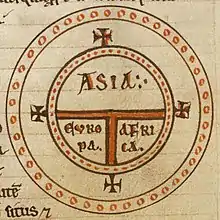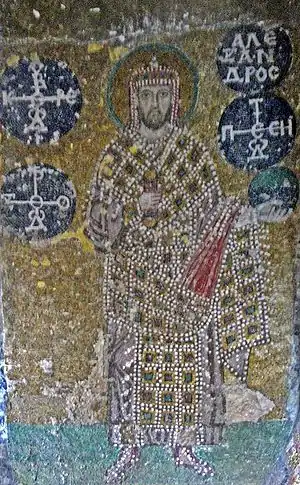Earth symbol
A variety of symbols or iconographic conventions are used to represent Earth, whether in the sense of planet Earth, or the inhabited world, or as a classical element. Representations of the globe of Earth, either with an indication of the shape of the continents or with a representation of meridians and parallels remains a common pictographic convention to express the notion of "worldwide, global". The modern astronomical symbol for Earth as a planet uses a circle with a cross (representing the equator and one meridian) is 🜨.[1]
| ⨁ ♁ 𓇾 𒆠 ☷ 土 🜃 | |
|---|---|
Earth symbol | |
| In Unicode | U+1F728 🜨 ALCHEMICAL SYMBOL FOR VERDIGRIS (HTML 🜨)U+2641 ♁ EARTH (HTML ♁) (Globus cruciger) U+131FE 𓇾 EGYPTIAN HIEROGLYPH N016 (HTML 𓇾) U+121A0 𒆠 CUNEIFORM SIGN KI (HTML 𒆠) U+2637 ☷ TRIGRAM FOR EARTH (HTML ☷) U+571F 土 CJK UNIFIED IDEOGRAPH-571F (HTML 土) U+1F703 🜃 ALCHEMICAL SYMBOL FOR EARTH (HTML 🜃) |
| Different from | |
| Different from | U+23DA ⏚ EARTH GROUND (HTML ⏚)Electrical earth (ground) |
History
The earliest type of symbols are allegories, personifications or deifications, mostly in the form of an Earth goddess (in the case of Egyptian mythology a god, Geb).
Before the recognition of the spherical shape of the Earth in the Hellenistic period, the main attribute of the Earth was its being flat. The Egyptian hieroglyph for "earth, land" depicts a stretch of flat alluvial land with grains of sand (Gardiner N16: 𓇾). Similarly, the Sumerian cuneiform sign for "earth" KI (𒆠) originates as a picture of a "threshing floor".
Earth, the classical element
In Chinese mysticism, the classical element "Earth" is represented by the trigram of three broken lines in the I Ching (☷). The Wu Xing system represents the element Earth as 土 (tǔ) (see 土 at Wiktionary).
The Western (early modern) alchemical symbol for earth is a downward-pointing triangle bisected by a horizontal line (🜃). Other symbols for the earth in alchemy or mysticism include the square and the serpent.[2]
The planet
In the Roman period, the globe, a representation of the spherical Earth, became the main symbol representing the concept. The globe depicted the "universe" (pictured as the celestial sphere) as well as the Earth.


The globus cruciger (♁) is the globe surmounted by a Christian cross, held by Byzantine Emperors on the one hand to represent the Christian ecumene, on the other hand the Akakia represented the mortal nature of all men.
In the medieval period, the known world was also represented by the T-and-O figure, representing an extremely simplified world map of the three classical continents of the Old World, viz. Asia, Europe and Africa.
Unicode has introduced a four characters representing the "globe" in the Miscellaneous Symbols and Pictographs block:
- EARTH GLOBE EUROPE-AFRICA U+1F30D 🌍
- EARTH GLOBE AMERICAS U+1F30E 🌎
- EARTH GLOBE ASIA-AUSTRALIA U+1F30F 🌏
- GLOBE WITH MERIDIANS U+1F310 🌐
See also
References
- "Solar System Symbols". NASA. 18 March 2019. Retrieved 8 December 2019.
- Jacobi, Jolande (2013). Complex/Archetype/Symbol in The Psychology Of C G Jung. Routledge. pp. 146–169. ISBN 9780415209397.
External links
| Wikimedia Commons has media related to Earth symbols. |